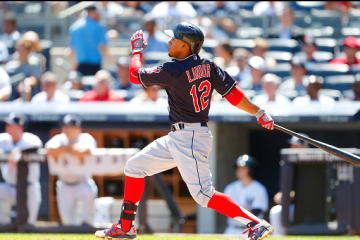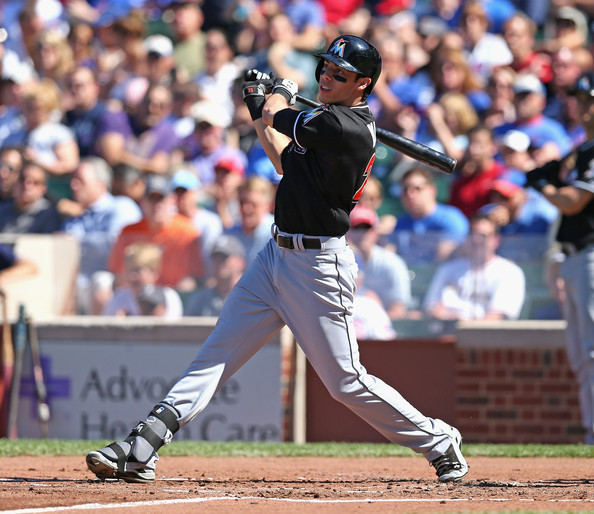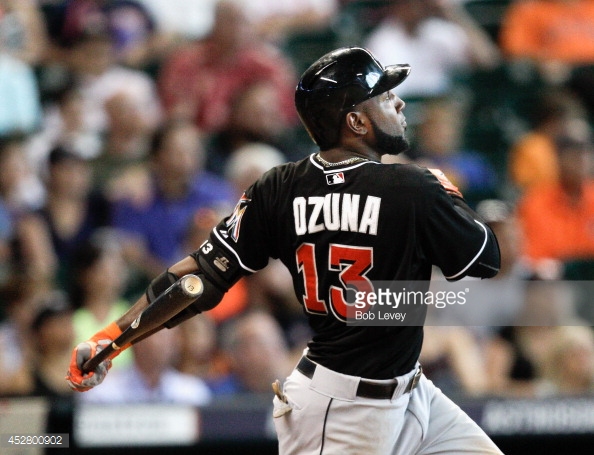2014 MLB Draft: The Hitters
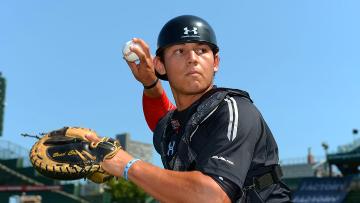
The 2014 crop of hitters kind of sucks. There will be big leaguers. There will probably even be a couple pretty good ones but, the draft class lacks both elite high-end talent at the top AND depth. While the overall class will likely go down as one of the worst in recent draft history, that doesn’t many any individual players are doomed to failure. Let’s take a look at the hitters who figure to go in the first round.
Alex Jackson – Rancho Bernardo HS (CA), C/OF
 Very likely the top position player taken in the upcoming draft, Jackson offers legit plus right-handed power, solid athleticism and, potentially, positional value. Jackson has caught and played the outfield on the showcase circuit where a his plus arm-strength is an asset both behind the dish and in right field.
Very likely the top position player taken in the upcoming draft, Jackson offers legit plus right-handed power, solid athleticism and, potentially, positional value. Jackson has caught and played the outfield on the showcase circuit where a his plus arm-strength is an asset both behind the dish and in right field.
Jackson’s swing has some length to it. He occasionally falls into the trap that a lot of young players do when they’re swinging for the fences, he loads a little too deep, bars his front arm and makes his swing a little stiff. This makes him susceptible to getting beat inside and by good velocity. An imposing physical presence, Jackson’s raw strength let’s him punish balls away and his power plays to center and even right-center, rare for a high school bat.
Perfect World: He’s a clean-up hitting, solid-defensive catcher.
More Likely: Jackson hits .260-.270 with 30 home runs and OK defense in right field, sort of a right-handed Jay Bruce – production wise.
Nick Gordon – Olympia HS (FL), SS
The only other offensive player guaranteed to go in the top 10, Gordon is an interesting foil to Alex Jackson. While Jackson’s game is power with a chance for positional value and enough athleticism to round things out, Gordon’s game is about speed and positional value with enough offensive skill to, hopefully, round things out.
A line-drive hitter who uses the whole field, Gordon should post good contact rates thanks to a quick batting stroke. Gordon has good wheels (though nowhere near as good as his brother, Dee) and a plus arm which should combine with soft hands and make him an asset as a true shortstop. Gordon has a little more pop than you might expect given his frame, 6-foot-2 and a very thin 170 pounds, but could grow into solid gap power and 10-12 home runs.
Perfect World: Gordon is a prototypical lead-off hitter and plus defender at short, making him one of the game’s better all-around players.
More Likely: A solid, everyday league-average big league starter who lends some fantasy value with 25-30 steals.
Kyle Schwarber – University of Indiana, C/OF
Schwarber has been one of college baseball’s best hitters for a couple of years and should keep on producing in the pros. Schwarber combines terrific bat speed with tremendous physical strength and underrated pure hitting ability to have the most presently usable power in the draft.
At an even six-feet tall and 240 pounds the Hoosier star has decent foot-speed but a below-average arm and probably won’t stay behind the plate in the pros. He does have more than enough athleticism to handle a corner outfield spot. Schwarber has an excellent eye at the plate, having walked 15.6% of the time this spring in route to a .351/.458/.640 slash line. Schwarber’s combination of production and underrated tools make him the draft’s best overall hitter.
Perfect World: One of the game’s best all-around hitters; a .290/.380/.525 guy with 35 bombs.
More Likely: Really freaking close that Perfect World scenario.
Trea Turner – North Carolina State University, SS
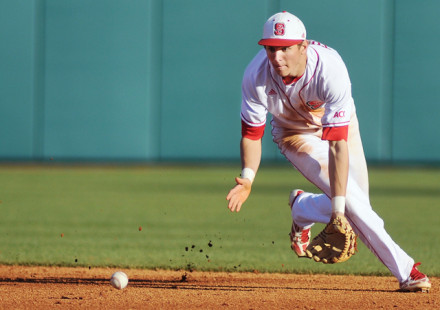 Speed is the most overrated baseball tool but, man, Trea Turner is really fast. Turner lead the nation in steals in 2012 as a freshman with 57 thefts in 61 attempts. He’s clocked 6.3 second 60 yard dash times and 3.5 seconds home-to-first; those are elite, 80 scouting grade numbers. Trea Turner has game-changing speed.
Speed is the most overrated baseball tool but, man, Trea Turner is really fast. Turner lead the nation in steals in 2012 as a freshman with 57 thefts in 61 attempts. He’s clocked 6.3 second 60 yard dash times and 3.5 seconds home-to-first; those are elite, 80 scouting grade numbers. Trea Turner has game-changing speed.
With decent hands and plenty of arm to play short, Turner has as much defensive upside as anyone in the draft.
Relatively healthy, after battling a high ankle sprain as a sophomore, Turner has hit .321/.418/.516 with excellent plate discipline numbers (37 BB and just 25 K in 256 plate appearances). Turner leads the Wolfpack in home runs (8) but his power is likely to max out as well-below-average in the Major League level. Turner’s swing is flat, geared for contact, and occasionally appears gangly. He covers the outer third well and does have enough bat speed to turn on the ball in. Turner’s shown some talent and a good hitting coach might coax more out of him. I’ve seen some reports give Turner a plus hit tool, but I think that’s a tad optimistic.
Perfect World: An elite defensive shortstop and good lead-off hitter who leads the world in steals.
More Likely: A No. 9 hitter whose glove is good enough to keep him in the lineup everyday and demon on the basepaths.
Michael Conforto – Oregon State University, OF
There are plenty of things not to like about Michael Conforto’s prospect status. He’s a sub-par athlete who’s limited to left-field defensively and may not even stick there. Offensively Conforto’s hit tool is mediocre, at best. He’s a physically maxed out, offensive-first guy without great pure hitting ability.
But, Conforto has good power and a patient approach. Conforto has walked in nearly one out of every five plate appearances for the Beavers this spring and has plus left-handed pull-power.
Perfect World: A middle-of-the-order thumper, .270/.360/.500 hitter with 25-30 homers.
More Likely: A .250/.330/.475 six-hole hitter who gives back some of his value on D.
Max Pentecost – Kennesaw State University, C
Pentecost was a well thought of high school prospect who slid to the seventh round after a stress fracture in his throwing arm derailed his senior season. After two OK, but not eye-popping, seasons Pentecost won the Cape Cod League MVP last summer then followed that up by going .424/.479/.631 this spring.
A good athlete with above-average wheels for a catcher, Pentecost has the physical ability, physique and arm strength to develop into an asset behind the plate. His swing is short but Pentecost doesn’t generate any real bat speed until very late in his swing. Pentecost hasn’t drawn that many walks for a high-level college player and his track record of big production is only a year long – two big red flags.
Perfect World: The uptick in production is indicative of an uptick in ability. He’s a league average, or slightly better, hitter and plus defensive catcher worthy of being a first-division starter
More Likely: A back-up catcher or Triple-A lifer, who struggles to get on-base vs elite level pitching and only offers marginal defensive value.
Bradley Zimmer – University of San Francisco, OF
Bradley Zimmer looks the part of one college baseball’s better athletes. Standing 6-foot-5 and 190 pounds Zimmer is lean and wiry, a front-of-the-bus guy. Not many guys his height play centerfield long-term in the Major Leagues and while Zimmer’s speed is plus, he does not have the kind of super-elite range that would eliminate all doubt as to his defensive home.
Zimmer has an up-the-middle approach with gap power, occasionally flashing a small home run threat to his pull side. Patience and pitch recognition are slight concerns as Zimmer is prone to chasing good breaking balls out of the zone.
Perfect World: A solid, well-rounded starting centerfielder. Producing like a bigger, left-handed Angel Pagan.
More Likely: A fourth-outfielder, platoon-type player. Not quite enough range for center, not enough power for a corner spot who has trouble against same-side pitchers with solid off-speed stuff.
Michael Chavis – Sprayberry HS (GA), SS
A high school shortstop, Chavis will shift to either second or, more likely, third-base in the pros. Despite losing positional value compared to short, Chavis has more than enough range and arm strength to be an asset at the hot corner.
While he may help a team with the glove, Chavis is going to be a first round pick because of his bat. Chavis is an impressive pure hitter, combining the ability to consistently barrel up balls with better power than you might expect from his 5-foot-10, 185 pound frame. He doesn’t offer much physical projection and is just a good, not great, athlete but Michael Chavis is the most offensively polished prep infielder in this draft class.
Perfect World: Chavis hits .290/.360/.500 with 25 home runs and 10 steals as a capable defensive second-baseman.
More Likely: Chavis is a solid defender at third who produces a Kyle Seager-like .265/.340/.440 and goes yard 20 times a season.
Monte Harrison – Lee’s Summit West HS (MO), OF
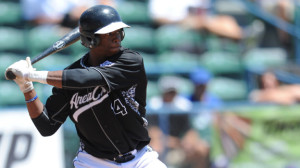 Best all-around athlete to enter the draft in a few years, Harrison is a top flight football prospect who is committed to Nebraska as a dual-sport recruit. Harrison’s wide receiver skills translate to the diamond where his terrific speed gives him excellent defensive range. Harrison also has one of the stronger arms in the draft, including pitchers, having been clocked as high as 97 MPH from the outfield.
Best all-around athlete to enter the draft in a few years, Harrison is a top flight football prospect who is committed to Nebraska as a dual-sport recruit. Harrison’s wide receiver skills translate to the diamond where his terrific speed gives him excellent defensive range. Harrison also has one of the stronger arms in the draft, including pitchers, having been clocked as high as 97 MPH from the outfield.
At the plate Harrison is a bit raw, but is not without skill. Harrison’s short stride, well-controlled weight-shift and small toe-tap timing mechanism let his explosive athleticism translate into plus bat-speed. There’s enough natural leverage in his swing that, combined with his raw physical strength, could develop into above-average power.
Perfect World: Harrison is an elite defensive CF and 25/25 threat, think early career Torii Hunter-like production.
More Likely: Still a real asset in CF but lacking the secondary offensive skills to become a star, the new Lorenzo Cain.
Jacob Gatewood – Clovis HS (CA), SS
No other player in this draft has such a huge gap between what he is now and what he could be. A 6-foot-5, 190 pound behemoth, Gatewood could add 30-40 pounds of muscle to his frame by the time he physically matures. His currently average speed will likely slow as he fills out, but Gatewood’s plus arm strength is plenty to hold down third base.
Gatewood has a huge power ceiling but is so raw that very little of that pop would make it over to games against professional hurlers right now. When people say there are “questions about Gatewood’s hit tool” there aren’t; his hit tool is virtually non-existent right now. The only question, singular, is how much will he improve. Gatewood is strong enough to show good bat speed but his sequencing, timing, swing path and pitch recognition all need work.
Perfect World: A 30-35 home run monster who makes up for low batting averages with power and above-average defense at third.
More Likely: He’ll win some minor league Home Run Derbies but remains too easy to pitch to to make an impact against the game’s best arms.
Derek Hill – Elk Grove HS (CA), OF
One of the fastest rising players in the draft, Hill began the draft process as a raw second or third round talent. During the spring he’s shown more and more consistent skill to compliment his outstanding athleticism.
The son of a scout, Hill projects as an outstanding defensive center-fielder thanks to plus-plus speed and solid arm strength. There’s not much loft in his swing, but Hill has a chance for an above-average hit tool thanks to quick, fluid hands and decent technical approach to hitting.
Perfect World: He finds ways to get on-base enough to hit at the top-of-the-order and battles Perfect World Monte Harrison for Gold Gloves throughout the 2020’s.
More Likely: His lack of power relegates Hill to the bottom-of-the-order but he carves out a solid MLB career thanks to speed and defense.
Stay tuned (people tune-in to websites, right?) for a similar piece about the draft’s top pitchers coming either tomorrow or Thursday…depending on how often my new puppy feels like chewing on the laptop’s power cord.


